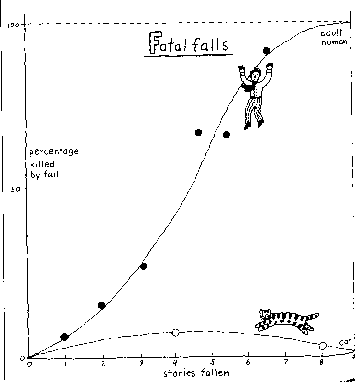
Terminal velocity, a rather chilling term, describes the velocity at which drag force from the air becomes equal to the force from the weight of an object, and thus the object no longer accelerates and consequently velocity remains constant. The greater an object's cross-sectional area and the less its mass, the lower the terminal velocity and the sooner it's reached. A cat reaches its terminal velocity of 60 mph within 5 stories of freefall. For comparison, a person's terminal velocity is 120 mph.
Once a cat reaches its terminal velocity, it then begins to slow down. This is because the cat relaxes, changing its position from back arched, head down, and legs pulled tightly underneath its body, to resemble a spread eagle cat. This increases its cross-sectional area and slows the cat down. The reason for this is that our bodies are only sensitive to acceleration (this is why at times on an airplane flight it feels as if you aren't moving at all). Relaxing also causes the impact force to be spread out over more area when the cat lands, resulting in a decrease in injuries to cats' limbs when they fall seven or more stories.

**This graph is taken from "How Cats Survive Falls from New York Skyscrapers." It plots the percentage of adult humans and cats killed by a fall versus the stories fallen. The adult human graph increases steadily to 100% while the cat graph increases to about 10% and then decreases to about 5% for falls from 7 to 9 stories. Although the graph doesn't show it, the survival rate holds steady at 95% from 9 to 32 stories.
Not only do cats seem to "understand" how increasing their area can lead to a less painful landing, they also seem to be well acquainted with the conservation of angular momentum, which they artfully use to land on their feet time and time again.